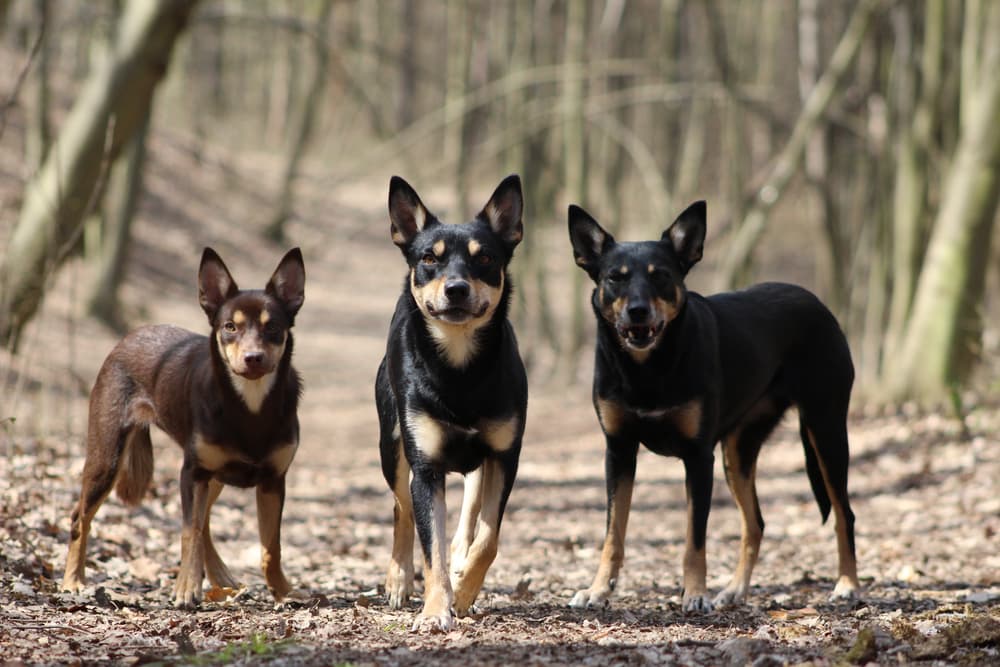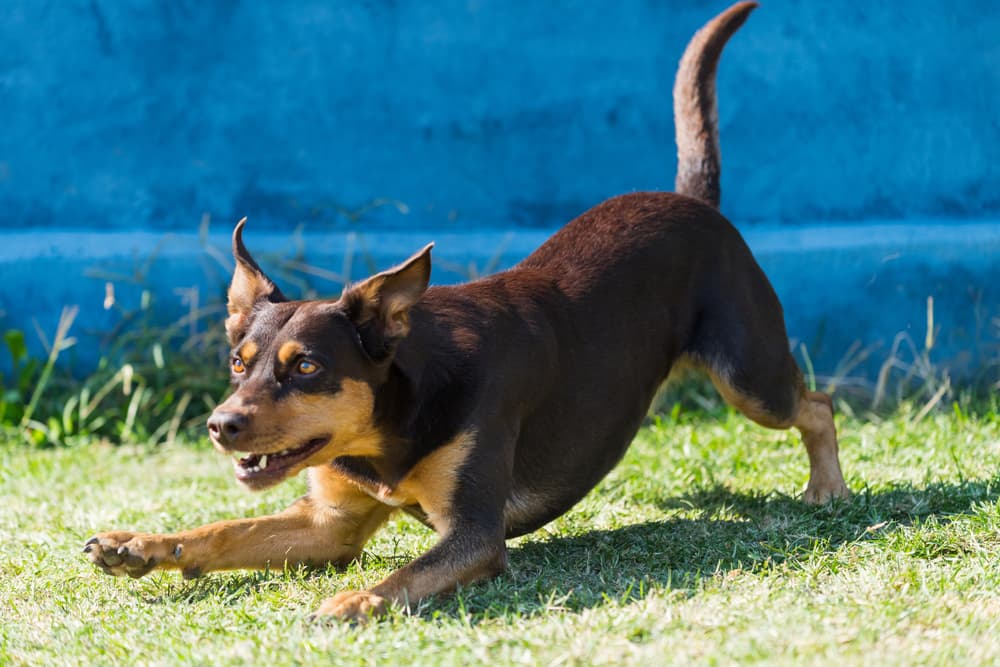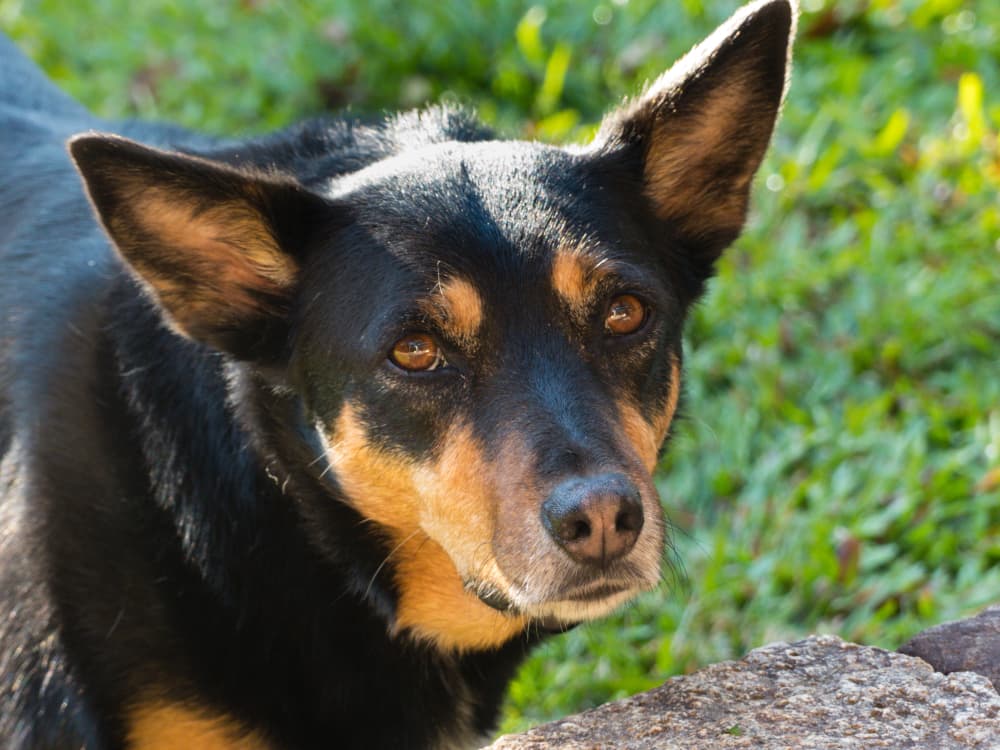Australian Kelpie

Breed Details
- Average Height: 17 to 20 inches at the shoulder
- Average Weight: 31 to 46 pounds
- Coloring: Black, red, blue, fawn, cream, black and tan, red and tan, blue and tan, or fawn and tan.
- Coat Type: Shortish double coat
- Dog Breed Group: Working
- Average Lifespan: 11 to 16 years
-
Key Personality Traits:
Energetic
Intelligent
Protective
Breed Characteristics
Adaptability
Affectionate
Apartment Friendly
Barking Tendencies
Cat Friendly
Child Friendly
Dog Friendly
Excercise Needs
Grooming
Health Issues
Intelligence
Energy Level
Shedding Level
Social Needs
Stranger Friendly
Territorial
Trainability
Watchdog Instincts
The Australian Kelpie is a capable and clever herding dog used to work sheep and other livestock in the United States and, or course, his homeland of Australia. Kelpies were created by crossing early Collies with other herding dogs and, possibly, Dingoes.
In Scottish and Irish mythology, a Kelpie is a magical water horse with malign intentions toward humans, especially children. The Australian Kelpie, on the other hand, is no such thing. He’s a capable and clever herding dog used to work sheep and other livestock in the United States and his homeland of Australia. Kelpies were created by crossing early Collies with other herding dogs and, possibly, Dingoes. They are medium-size dogs, weighing 31 to 46 pounds.
Can you provide this highly intelligent dog with a challenging job? Are you able to provide loving leadership, fair and consistent training, and plenty of daily exercise? If you can answer yes to all of these questions, the Australian Kelpie might be right for you. If you’re not sure, then you are right to hesitate before acquiring a Kelpie. One that is underemployed can wreak all kinds of destruction in his attempts to find a job for himself.
Understand the Kelpie’s working style before you bring him home. Australian Kelpies herd livestock by nipping at the animals’ heels. If they don’t have a flock to manage, they may transfer this behavior to children, other pets, and vehicles such as bicycles and cars. Never let it go uncorrected, and then redirect the behavior by giving your Australian Kelpie demanding and interesting work or games that will provide him with the exercise and mental stimulation he needs.
A Kelpie can be a search and rescue dog, detection dog, hearing dog, assistance dog, or therapy dog. He’s great at dog sports: agility, flyball, flying disc games, herding trials, obedience and tracking. A couple of long daily walks, jogs or hikes will also help to meet his need for activity. It takes a lot of time and effort to keep him occupied to his satisfaction.
One task at which the Kelpie excels is that of watchdog. He has an alert nature and will bark to let you know of anything or anyone unusual.
The Australian Kelpie is bred to work with people. If your Kelpie is a family pet, he needs to live indoors; that is, when he’s not out with you playing, jogging, working or showing up all the other dogs at the local agility or obedience trial. Otherwise, he’ll be lonely, bored and destructive.
Other Quick Facts
- The Kelpie is highly intelligent and needs a job to keep his clever mind occupied.
- The Kelpie has a shortish double coat that comes in black, red, blue, fawn, cream, black and tan, red and tan, blue and tan, and fawn and tan.
The History of the Kelpie

Like so many of the breeds that exist today, the Kelpie came into being in the late 19th century, probably around 1870. The sheep and wool industry in Australia was becoming big business, and ranchers needed tough dogs who could not only handle the unruly sheep but also the harsh environmental conditions and vast acreages. The Kelpie’s ancestors include the “coley,” a British herding-type dog that may also have contributed to the development of the Border Collie, the English Shepherd, and the Australian Shepherd.
Kelpies were brought to North America about a century ago and adapted easily to the varying climates and terrain, as well as different livestock. They are rare in the sense that they are not commonly seen as pets, but thousands of them go to work everyday on farms and ranches around the world. They are recognized by the United Kennel Club and registered by the North American Australian Kelpie Registry, which has the goal of preserving the Kelpie’s natural working ability, purpose, conformation, temperament and overall good health.
Kelpie Temperament and Personality

The Kelpie’s breed standard describes him as extremely alert and eager with a mild, tractable disposition and an almost inexhaustible energy. He is noted for his loyalty and devotion to his work. This is a highly intelligent and capable dog. He likes to have a job to do, and whatever it is, he will do it well.
Be prepared to provide him with work that will satisfy him, whether that is bringing things to you — the paper, your slippers, dirty laundry left on the floor — competing in agility or obedience, accompanying you on errands or helping you keep an eye on the kids at the park. If you can teach it, he can learn it. Do not underestimate the amount of time and energy it will take to train and live with this dog if you can’t provide him with his traditional herding work or an outlet such as dog sports.
Being a herding dog, the Kelpie’s instinct is to work on his own and think for himself. In his mind, you are a partner, not a boss. Take that into account when you are training him. Respect his intelligence and don’t drill him over and over when it’s clear that he already knows something. This is a dog that is accustomed to and capable of working on his own with little or no supervision.
The Kelpie’s herding heritage can work against him in one way, making him wary of anything or anyone unusual. That’s beneficial to an extent—it’s one of the things that makes him a good watchdog, but early, frequent socialization is critical to prevent a Kelpie from becoming overly suspicious or fearful of anything new or different. Purchase your Kelpie puppy from a breeder who raises the pups in the home and ensures that they are exposed to many different household sights and sounds, as well as people, before they go off to their new homes. Run far away from breeders who raise their pups in a barn or a pen out in the backyard. An Australian Kelpie who is to be a family companion needs plenty of socialization. Continue socializing your Kelpie throughout his life by taking him to puppy kindergarten class, the homes of friends and neighbors, and dog-friendly shops and businesses.
Train the Kelpie with a firm hand and consistent direction. For best results, begin training during his first week at home, keep training sessions short, and use positive reinforcement techniques, never force, which is likely to backfire.
What You Need To Know About Kelpie Health

The Kelpie is a generally healthy breed, but like all dogs, he still has the potential to develop genetic health problems.
Some health issues are more common to Kelpies than others. They include Collie eye anomaly, progressive retinal atrophy (PRA) and cerebellar abiotrophy.
Cerebellar abiotrophy is a progressive neurological disease that affects movement. It has no treatment, but researchers are seeking a genetic marker for the disease, which could eventually aid breeders in identifying Kelpies who are affected by or carriers of the disease.
Preventing potentially dangerous genetic conditions from occurring in your Kelpie begins with choosing the right breeder. Not all of these conditions are detectable in a growing puppy, but finding a reputable breeder who is committed to breeding the healthiest animals possible is a start. These breeders will have completed screenings for common defects before breeding their dogs and will be able to produce independent certifications verifying their health.
However, beware of potential red flags: If a breeder tells you her dogs have been “vet checked” or that she’s never had any problems in her lines, therefore negating the necessity for genetic testing, you should look for another breeder.
Not all health issues are genetic, however. Some, like obesity, are within your control as a dog parent to prevent. Keeping a Kelpie at an appropriate weight is one of the easiest ways to extend his life. Make the most of your preventive abilities to help ensure a healthier dog for life.
The Basics of Kelpie Grooming
Brush the Kelpie’s coat once or twice a week to remove dead hair and keep shedding to a minimum. Some Kelpies have a double coat that sheds heavily in the spring. You’ll need to brush him more often to keep the loose hair under control. Active Australian Kelpies often wear their nails down naturally, but it’s a good idea to check them weekly to see if they need a trim. Otherwise, just keep the ears clean and give him a bath if he gets dirty. Brush his teeth frequently for good overall health and fresh breath.
Choosing a Breeder for Your Kelpie

One important thing to know about Australian Kelpies is that there are two types: those bred strictly for their herding talents and those bred for the show ring. The herding dogs tend to weigh less and stand taller than show dogs. Other differences are ear set and coat type and color. Kelpies bred for the show ring have prick ears and wear a short double coat that comes only in solid colors.
Kelpies are not recognized by the American Kennel Club, so you will see the show variety only at United Kennel Club shows or rare breed shows. While they might not be as well suited to working stock as their herding brethren, they can be super competitors in agility, obedience and other dog sports.
All of that is to say that it’s important to know the dog’s background before purchasing a puppy. If you plan to actually work stock with your Australian Kelpie, you will want a puppy from working lines. If you want a family companion or a competitor for dog sports, one from show lines may be a better choice.
If you want a good puppy, you need to start by finding a good breeder. A good breeder will match you with the right puppy will be able to show all the necessary health certifications.
Also, good breeders will welcome your questions about temperament, health clearances, and personality. In return, they’ll ask you questions of their own about what you’re looking for in a dog and what kind of life you can provide for him.
At the end of the day, the goal of a reputable breeder is to get her puppies in the right homes, not turn an enormous profit. So, be wary of breeders who only seem interested in how fast they can get rid of puppies and whether your check will clear. When you are researching breeders online, red flags include puppies always being available, multiple litters on the premises, having your choice of any puppy, and the ability to pay online with a credit card. Those things are convenient, but they are almost never associated with reputable breeders.
Before bringing home a puppy, have you considered an adult Kelpie instead? While everyone loves puppies, not everyone loves (or is equipped to) handle the responsibility of raising one. Adult Kelpies may already have some training and will likely be less active, destructive and demanding. Many retired show or work dogs may be looking for a new home, so think about that the next time you get Kelpie puppy fever!
Adopting a Kelpie from a Rescue or a Shelter

So you want to adopt an Australian Kelpie — where do you even begin? There are many great options available if you want to adopt a dog from an animal shelter or breed rescue organization. Here are few tips to get started.
Search Online. Yes, Google might be enough to help you find an adoptable Kelpie. But sites like Petfinder.com and Adopt-a-Pet.com can help you narrow your search using specific filters like housetraining status or georgraphic radius. These tools can be valuable if you’re looking for a Kelpie with very specific characteristics or in a defined geographic region. AnimalShelter is another great site to help you find animal rescue groups in your area.
Network With Local Experts. Start a conversation with all the pet pros in your area about how you want to adopt a Kelpie. Veterinarians, dog walkers, groomers and anyone else who works closely with dogs may have insight into where you can find an adoptable Kelpie and can serve as your eyes and ears. Who better to turn to to find a dog than dog people?
Reach Out to a Kelpie Breed Rescue. Most people who love Kelpies love all Kelpies. That’s why breed clubs have rescue organizations devoted to taking care of homeless dogs. The North American Australian Kelpie Registry’s network may help you find a rescue dog that may be the perfect companion for your family. You can also search online for other Kelpie rescues in your area.
Follow those tips, and you’ll find a Kelpie in no time. But the work doesn’t end there. Soon after you adopt a Kelpie, get him to see a veterinarian. Your veterinarian will be able to spot problems and will work with you to set up a preventive regimen that will help you avoid many health issues.
Australian Kelpie FAQs
Do Australian Kelpies shed?
Don’t be fooled by their short coat—Kelpies do tend to shed substantially. A regular brushing and bathing routine will help control the hair covering your carpet and furniture, but know what you’re getting into before bringing one home.
Are Australian Kelpies aggressive?
Kelpies generally make great family pets and are rarely aggressive. As with any breed of dog, however, your Kelpie should be trained and socialized from a very early age to prevent reactive and dangerous behaviors later in life. Kelpies are also known to be protective of their families. So if your Kelpie notices anything or anyone threatening your loved ones, he may step in to play guard dog.
Are Australian Kelpies good family dogs?
Yes! Australian Kelpies are loved for their intelligence, loyalty, and protectiveness. Although they are determined working-breed dogs, they are typically gentle enough to keep children and other household pets safe.
Are Australian Kelpies good guard dogs?
Kelpies are often labeled as “velco” dogs, meaning wherever his human goes he will follow. As such, he will quietly show loyalty to his human family and protect them if necessary. However, Kelpies are not known to be biters, so if you expect a scary and dangerous guard dog out of your Kelpie, you may be disappointed.
Australian Kelpie Pictures



















